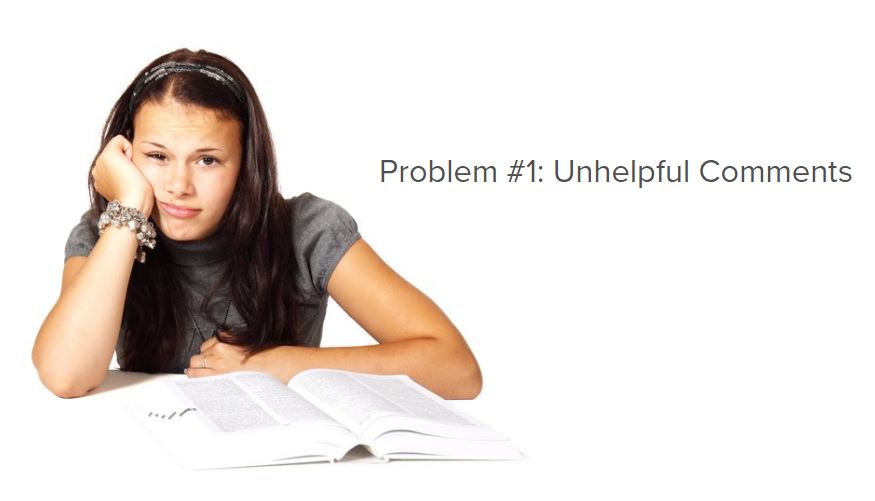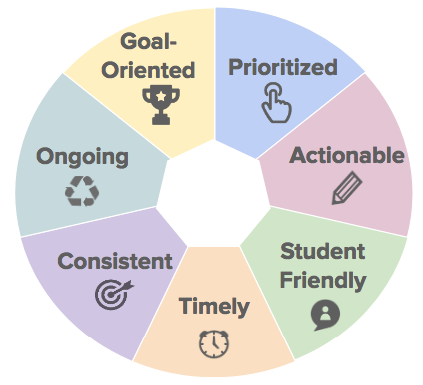
The Challenges with Peer Reviews and How to Solve Them
Peer review is a winning strategy for teachers and students – if done well. Once teachers understand the basics and benefits of peer review, a myriad of implementation challenges arise. Let’s dive into the two biggest challenges and some recommended ways to tackle them.
- Students giving vague and unhelpful comments
- Students simply not taking peer review seriously enough
These problems can often overlap—since not taking peer review seriously can lead to vague comments—and can be motivated by deeper issues, like students being worried about the social repercussions of criticizing a peer’s paper. The solutions offered below will help make your students more comfortable with peer review and more serious about its benefits at the same time.
PROBLEM #1: STUDENTS GIVING VAGUE AND UNHELPFUL COMMENTS
SOLUTIONS WE’LL EXPLORE:
- Making peer review anonymous
- Building constructive classroom culture
- Using the 7 Hallmarks of Effective Feedback
- Modeling mock peer review
- Assigning writer memos
PROBLEM #2: STUDENTS NOT TAKING PEER REVIEW SERIOUSLY ENOUGH
SOLUTIONS WE’LL EXPLORE:
- Grading peer review
- Explaining the relevance of peer review

The single greatest challenge with peer review is ensuring and improving the quality of the feedback that students offer to their peers.
Many teachers complain that their students frequently stick to vague positive comments like “Great work!” In a sense though, this kind of response has its own logic. One teacher asked their students about what makes peer review difficult, and here’s what they said:
- “My partner’s essay was so much better than mine was that I didn’t feel like I could even help her.”
- “I didn’t want to hurt my partner’s feelings.”
- “There were so many mistakes, I didn’t know where to start.”
When confronted with any of these cases, wouldn’t it be easier to just say “great work!” and move on?
Another teacher empathizes with the tough social component of peer review: “I feel like I am putting them in a lose/lose situation.” A student can either
- Fail to provide their peer with anything helpful, or
- “Do something that could potentially hurt another person’s self-worth” and “be seen as knit-picky and pedantic.”
It’s no wonder so many students choose the former.
Solution 1: Anonymous Reviews
One of the most obvious solutions to this problem is to make peer review anonymous. Indeed, one recent study found that the quality of peer review feedback increases when students remain anonymous.
A student in another study on the same topic explained, “I feel that the idea of being anonymous helps me and my peers feel more comfortable because not only does it help if you have a bad paper but if a student gives constructive criticism it could lead to taunting and/or bullying.”
While there are programs, such as Peergrade and Peerceptiv, that exist to facilitate anonymous peer review, it is also possible for teachers to anonymize drafts themselves by assigning random numbers to each paper before passing them out.
However, there are substantial drawbacks to anonymous peer review.
Making peer review anonymous means that there can be no open discussion about students’ work, no reading papers aloud or follow up questions from the writer. Luckily, there are other ways to mitigate the high social stakes of peer review.
In a way, even if you don’t choose to keep papers anonymous, the studies that support anonymous peer review are a “good reminder for teachers to consider how social relationships and goals can influence even ‘best practices’ in writing instruction.”
Solution 2: Constructive Classroom Culture
One teacher eases the difficulty of reviewing others by “fostering a culture of constructive criticism” in her classroom and “creating a classroom climate that accept[s] faults and imperfection.” She emphasizes to her students that “in real life we all need others to make ourselves better.”
Teachers should also make sure that they don’t pit students against each other during activities or play favorites during class discussions—anything that creates a power imbalance in the classroom could worsen fear of bullying during peer review.
Another way to build a classroom culture around constructive criticism would be to practice critiquing a “real life” published or professional essay during class. For example, in an AP class, you could take a sample essay released by the College Board that scored a 9, the highest possible score, and work to critique the essay constructively as a class.
By revealing that even perfectly scored essays can be improved, you will show your students that critique is not something left for “bad writing” but something necessary for all writing. The same could be done with an opinion piece from the New York Times (or another well-known newspaper) to emphasize the same principle on an even larger scale.
Solution 3: The Seven Hallmarks of Effective Feedback
Another way to improve the quality of student comments and reduce the social risk of giving substantive feedback is to establish a very clear standard for the type of comments that all students should be giving during peer review.
If students know that “Good job!” is not an acceptable response (and why), they will be less likely to resort to that kind of language.
One guide to meaningful peer review suggests using Grant Wiggins’s seven keys for effective feedback. According to Wiggins, effective feedback is:
- Goal-oriented
- Prioritized
- Actionable
- Student-friendly
- Timely
- Ongoing
- Consistent
For elaboration on any of these criteria, check out our guide here. The trained online teaching assistants at Marco Learning also use these hallmarks to guide their responses to student work. If you partner with Marco Learning to get your students more high-quality feedback, you could even use an assignment that a grader responds to as a sample to show what the goal-oriented, prioritized, actionable, and student-friendly feedback looks like.

Solution 4: Mock Peer Review
To further establish high standards for student responses, many teachers recommend holding mock peer review sessions before students jump into reviewing on their own.
One teacher advocates using anonymous papers from students in other sections or past years to guide an in-class critique session. Using a student-produced sample allows students to have a realistic product with which to compare their own paper; discussing the kind of comments that would be helpful to provide for that paper gives students “the language necessary to discuss areas of strength in their peers’ work and areas in need of improvement.”
When facilitating the mock peer review, it may be helpful to have students fill out the same peer review worksheet that you’ll have them use for real peer review and to volunteer aloud what they are writing down.
If you don’t have a worksheet in mind yet, feel free to modify and use this one from ReadWriteThink. This way, as one teacher explains, “if a student comments, ‘I like the first paragraph,’ you might ask, ‘can you tell the writer what you find effective or appealing about that paragraph? And why?’”
As students become more critical and constructive, it might be necessary to remind them “to construct their comments as if the writer were indeed in the room, listening” so the mock peer review is as close to the real peer review as possible.
If you don’t have time for a mock peer review or want to give students a refresher halfway through the year, this worksheet on sample peer review comments might be a valuable resource.
Solution 5: Writer Memos
Another creative way to encourage students to provide more constructive feedback for their peers is to instruct students to write memos to bring to class along with their drafts.
Professor Christina Moore, the main proponent of this method, suggests that students’ memos should have two parts: a context paragraph and a list of questions. The context paragraph can include:
- Anything it would be helpful for the reviewer to know
- What the writer already understands about their work
- What the writer wants and needs from the reviewer
- The paper’s stage of development, purpose, struggles, and intentions
After the context paragraph, the list of questions will help the writer reflect on their own paper and help the reviewer focus their attention while reading and responding.
Modeling context paragraphs and lists of questions for students the same way that you model peer review responses could be an easy way to set students on the right track.

The last challenge with peer review is that students often don’t take peer review seriously enough.
If students are not used to getting helpful peer feedback on their own papers and don’t see themselves as authoritative enough to provide feedback for others, they will often put minimal effort into peer review.
Aside from making the entire process better for students through implementing the previous ideas, there are a few specific ways to inspire students to approach peer review more positively.
Solution 1: Graded Peer Review
FIRSTLY, AND PERHAPS MOST OBVIOUSLY, YOU CAN GRADE PEER REVIEW.
Once you’ve established the criteria and standards that you’ll use for peer review responses, you “might decide to use a straightforward √- √ √+ system, or…assign a point-value to different aspects of the work required for peer review” to indicate how closely each student meets those standards.
An even more vital way to engage students in the peer review process is to explain why peer review matters. One professor points out that “if students don’t understand the purposes of peer review, they will see it as mere busy work” and recommends taking time to clarify the goals for peer review before, during, and after peer review sessions.
These goals can include the aim for peer reviewing that specific paper as well as the aims of peer review more broadly: learning to be critical readers and writers, providing others with encouragement and new ideas, etc.
Solution 2: Peer Review in the World
It can also help to emphasize how essential peer review is to the professional and academic writing process. If you have published articles or books, you could tell your students “about a specific instance when a reader’s comments helped you to clarify and strengthen your writing.”
On a broader scale, the American Psychological Association (APA) reports that most of the articles that they publish are only accepted “with contingencies,” meaning that the authors must revise their work based on peer feedback.
Even engineers writing project proposals or businesspeople writing grants usually have to consider and accept changes from peers and colleagues as part of the process.
If you are aware of the future career aspirations of your students, do a few minutes of research; it could be powerful for them to hear about how peer review (or even collaboration more generally) might be a part of their future work.
Peer review is not a relic resigned to high school English classes—mastering it can prove to be helpful in any field and any occupation. When students can imagine peer review as part of their future, they will be more likely to engage fully in the peer review process in present.
Peer review is often an unpopular activity among students, but it doesn’t have to be that way.
When teachers emphasize the purpose and benefits of peer review, mitigate the social risks of commenting on peers’ work, and communicate high expectations for the quality of student feedback, students might start to see peer review for what it is—a valuable tool for growth.
Getting students excited about working together at all ages will help to prepare them for the real world in which collaborating and critiquing in the workplace is inevitable and necessary.
 Help
Help